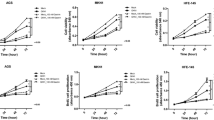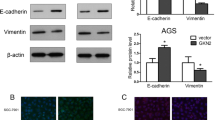Abstract
Purpose
Gastrokine 1 (GKN1) plays an important role in the gastric mucosal defense mechanism and also acts as a functional gastric tumor suppressor. The specific aim of this study was to determine the molecular mechanisms underlying GKN1 tumor suppressor activity in the progression of gastric cancers.
Methods
We examined the effect of GKN1 on epithelial–mesenchymal transition (EMT) and cell migration in GKN1-transfected and recombinant GKN1-treated AGS gastric cancer cells using in vitro wound healing, microchemotaxis, and invasion assays.
Results
In GKN1-transfected AGS cells, we observed inhibition of cell migration and invasion in wound healing, transwell and Matrigel assay. Also, GKN1-transfected and recombinant GKN1-treated AGS cells showed decreased levels of ROS and expression of phosphatidylinositol 3-kinase (PI3K)/Akt pathway proteins, concomitant with re-expression of E-cadherin and decreased expression of cytoplasmic and nuclear expression of β-catenin, slug, snail, fibronectin, and vimentin.
Conclusions
These data suggest that the GKN1 gene may play an important role in the progression of sporadic gastric cancers via inhibition of EMT and cancer cell migration.




Similar content being viewed by others
Abbreviations
- GKN:
-
Gastrokine
- EMT:
-
Epithelial–mesenchymal transition
- ROS:
-
Reactive oxygen species
- PBS:
-
Phosphor-buffered saline
- PVDF:
-
Polyvinylidene difluoride
References
Ang KL, Shi DL, Keong WW, Epstein RJ (2005) Upregulated Akt signaling adjacent to gastric cancers: implications for screening and chemoprevention. Cancer Lett 225:53–59
Babyatsky MW, deBeaumont M, Thim L, Podolsky DK (1996) Oral trefoil peptides protect against ethanol- and indomethacin-induced gastric injury in rats. Gastroenterology 110:489–497
Cavallaro U, Christofori G (2004) Multitasking in tumor progression: signaling functions of cell adhesion molecules. Ann N Y Acad Sci 1014:58–66
Frixen UH, Behrens J, Sachs M, Eberle G, Voss B, Warda A, Löchner D, Birchmeier W (1991) E-cadherin-mediated cell–cell adhesion prevents invasiveness of human carcinoma cells. J Cell Biol 113:173–185
Jemal A, Murray T, Ward E, Samuels A, Tiwari RC, Ghafoor A, Feuer EJ, Thun MJ (2005) Cancer statistics, 2005. CA Cancer J Clin 55:10–30
Jücker M, Südel K, Horn S, Sickel M, Wegner W, Fiedler W, Feldman RA (2002) Expression of a mutated form of the p85alpha regulatory subunit of phosphatidylinositol 3-kinase in a Hodgkin’s lymphoma-derived cell line (CO). Leukemia 16:894–901
Kalluri R, Neilson EG (2003) Epithelial-mesenchymal transition and its implications for fibrosis. J Clin Invest 112:1776–1784
Kalluri R, Weinberg RA (2009) The basics of epithelial-mesenchymal transition. J Clin Invest 119:1420–1428
Larue L, Bellacosa A (2005) Epithelial-mesenchymal transition in development and cancer: role of phosphatidylinositol 3′ kinase/AKT pathways. Oncogene 24:7443–7454
Martin TE, Powell CT, Wang Z, Bhattacharyya S, Walsh-Reitz MM, Agarwal K, Toback FG (2003) A novel mitogenic protein that is highly expressed in cells of the gastric antrum mucosa. Am J Physiol Gastrointest Liver Physiol 285:G332–G343
Nardone G, Rippa E, Martin G, Rocco A, Siciliano RA, Fiengo A, Cacace G, Malorni A, Budillon G, Arcari P (2007) Gastrokine 1 expression in patients with and without Helicobacter pylori infection. Dig Liver Dis 39:122–129
Oien KA, McGregor F, Butler S, Ferrier RK, Downie I, Bryce S, Burns S, Keith WN (2004) Gastrokine 1 is abundantly and specifically expressed in superficial gastric epithelium, down-regulated in gastric carcinoma, and shows high evolutionary conservation. J Pathol 203:789–797
Oki E, Baba H, Tokunaga E, Nakamura T, Ueda N, Futatsugi M, Mashino K, Yamamoto M, Ikebe M, Kakeji Y, Maehara Y (2005) Akt phosphorylation associates with LOH of PTEN and leads to chemoresistance for gastric cancer. Int J Cancer 117:376–380
Radisky DC, Levy DD, Littlepage LE, Liu H, Nelson CM, Fata JE, Leake D, Godden EL, Albertson DG, Nieto MA, Werb Z, Bissell MJ (2005) Rac1b and reactive oxygen species mediate MMP-3-induced EMT and genomic instability. Nature 436:123–127
Shin HR, Jung KW, Won YJ, Park JG (2004) 139 KCCR-affiliated hospitals. 2002 annual report of the Korea central cancer registry: based on registered data from 139 hospitals. J Korean Cancer Assoc 36:103–114
Shiozaki K, Nakamori S, Tsujie M, Okami J, Yamamoto H, Nagano H, Dono K, Umeshita K, Sakon M, Furukawa H, Hiratsuka M, Kasugai T, Ishiguro S, Monden M (2001) Human stomach-specific gene, CA11, is down-regulated in gastric cancer. Int J Oncol 19:701–707
Toback FG, Walsh-Reitz MM, Musch MW, Chang EB, Del Valle J, Ren H, Huang E, Martin TE (2003) Peptide fragments of AMP-18, a novel secreted gastric antrum mucosal protein, are mitogenic and motogenic. Am J Physiol Gastrointest Liver Physiol 285:G344–G353
Vivanco I, Sawyers CL (2002) The phosphatidylinositol 3-kinase AKT pathway in human cancer. Nat Rev Cancer 2:489–501
Walsh-Reitz MM, Huang EF, Musch MW, Chang EB, Martin TE, Kartha S, Toback FG (2005) AMP-18 protects barrier function of colonic epithelial cells: role of tight junction proteins. Am J Physiol Gastrointest Liver Physiol 289:G163–G171
Wang Z, Li Y, Sarkar FH (2010) Signaling mechanism(s) of reactive oxygen species in epithelial-mesenchymal transition reminiscent of cancer stem cells in tumor progression. Curr Stem Cell Res Ther 5:74–80
Willipinski-Stapelfeldt B, Riethdorf S, Assmann V, Woelfle U, Rau T, Sauter G, Heukeshoven J, Pantel K (2005) Changes in cytoskeletal protein composition indicative of an epithelial-mesenchymal transition in human micrometastatic and primary breast carcinoma cells. Clin Cancer Res 11:8006–8014
Wu WS (2006) The signaling mechanism of ROS in tumor progression. Cancer Metastasis Rev 25:659–705
Xing R, Li W, Cui J, Zhang J, Kang B, Wang Y, Wang Z, Liu S, Lu Y (2011) Gastrokine 1 induces senescence through p16/Rb pathway activation in gastric cancer cells. Gut (in press)
Yoon JH, Song JH, Zhang C, Jin M, Kang YH, Nam SW, Lee JY, Park WS (2011) Inactivation of the Gastrokine 1 gene in gastric adenomas and carcinomas. J Pathol 223:618–625
Zhang KH, Tian HY, Gao X, Lei WW, Hu Y, Wang DM, Pan XC, Yu ML, Xu GJ, Zhao FK, Song JG (2009) Ferritin heavy chain-mediated iron homeostasis and subsequent increased reactive oxygen species production are essential for epithelial-mesenchymal transition. Cancer Res 69:5340–5348
Acknowledgments
We thank Dr. In Beom Kim at Department of Anatomy, College of Medicine, The Catholic University of Korea, for helpful discussion. This work was supported by the Happy tech. program through the National Research Foundation of Korea (NRF) funded by the Ministry of Education, Science and Technology (2010-0020764).
Conflict of interest
The authors have no conflicts to disclose.
Author information
Authors and Affiliations
Corresponding author
Electronic supplementary material
Below is the link to the electronic supplementary material.
432_2011_1051_MOESM1_ESM.tif
Effect of GKN1 recombinant protein on cell migration in AGS cancer cells. A scratch wound healing assay demonstrated that cell migration into the wound area was significantly inhibited in cells treated with recombinant GKN1 compared to control in a dose-dependent manner. The dotted lines indicate the original edges of the scratch defect. (TIFF 765 kb)
432_2011_1051_MOESM2_ESM.tif
The effect of GKN1 recombinant protein on cellular ROS levels. Treatment of GKN1 recombinant protein significantly decreased ROS levels in AGS cells in a dose-dependent manner. The results are presented as mean ± SD of a triplicate from a representative experiment. (TIFF 337 kb)
Rights and permissions
About this article
Cite this article
Yoon, J.H., Kang, Y.H., Choi, Y.J. et al. Gastrokine 1 functions as a tumor suppressor by inhibition of epithelial–mesenchymal transition in gastric cancers. J Cancer Res Clin Oncol 137, 1697–1704 (2011). https://doi.org/10.1007/s00432-011-1051-8
Received:
Accepted:
Published:
Issue Date:
DOI: https://doi.org/10.1007/s00432-011-1051-8




